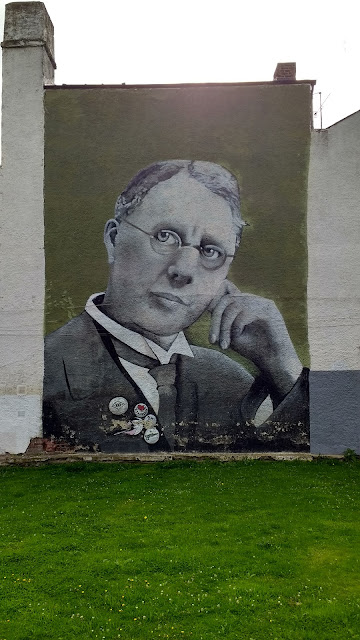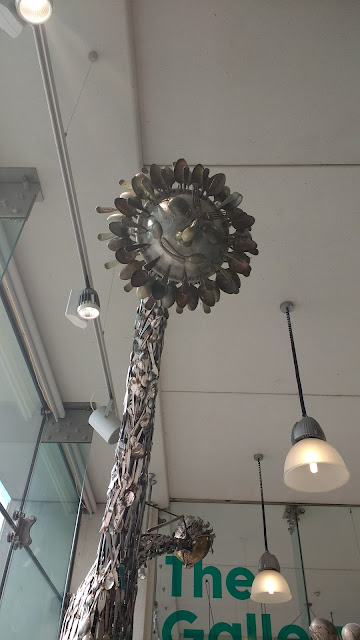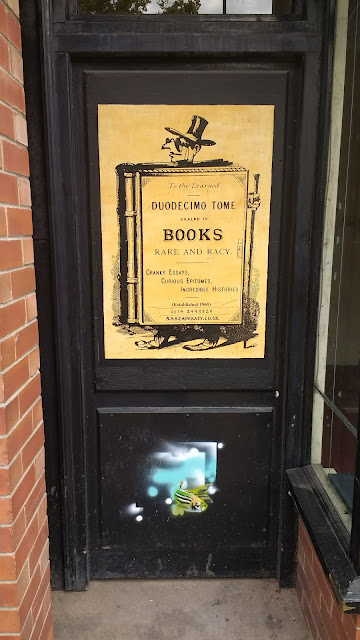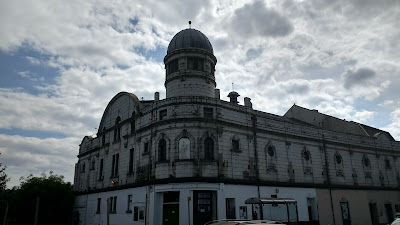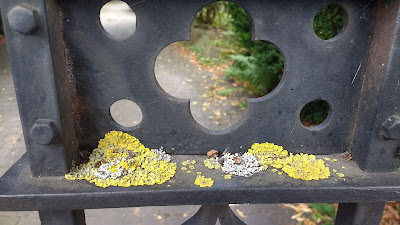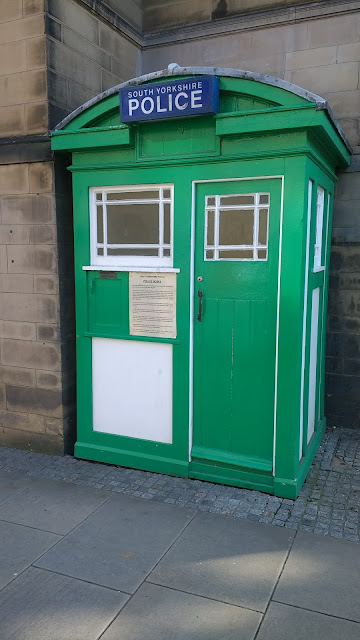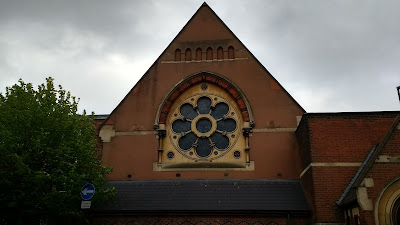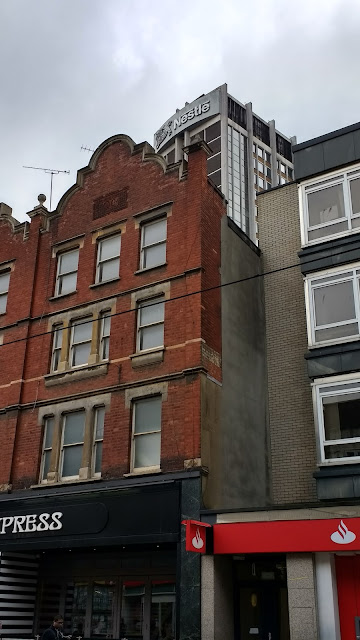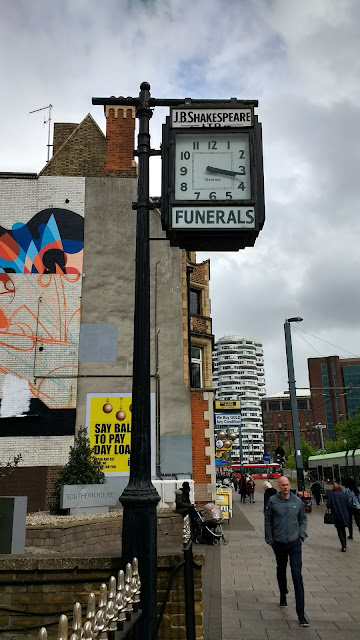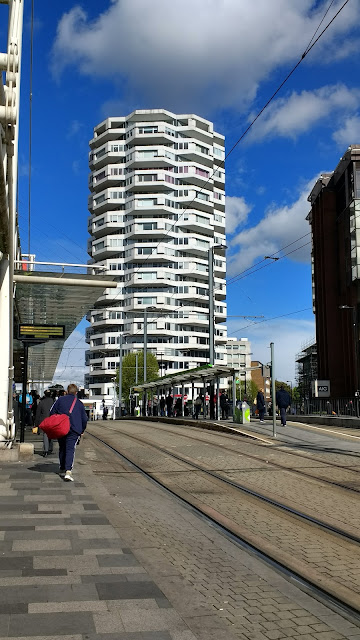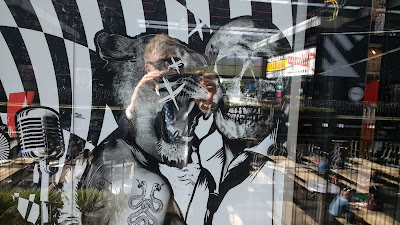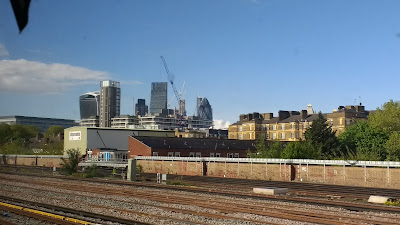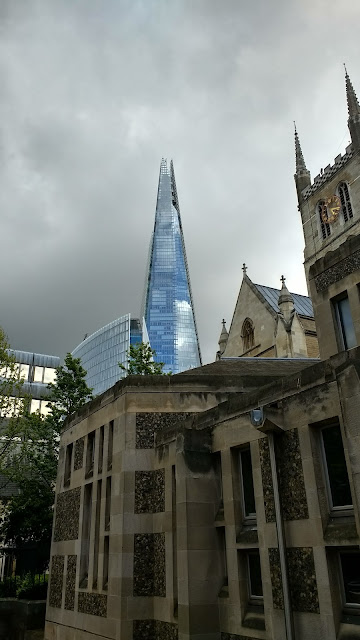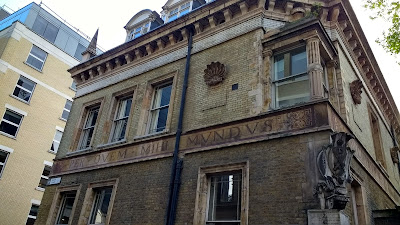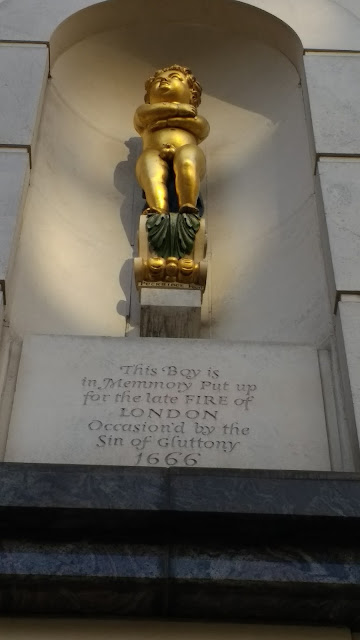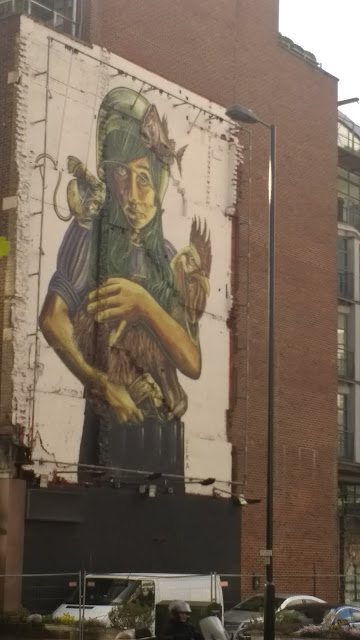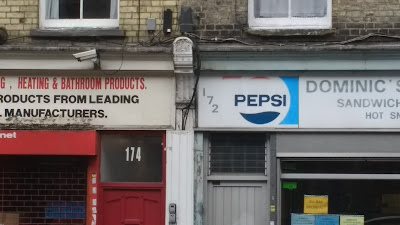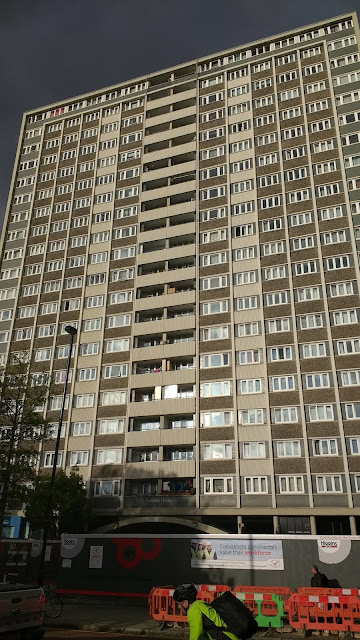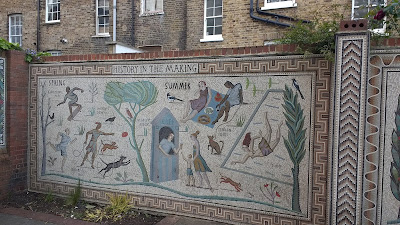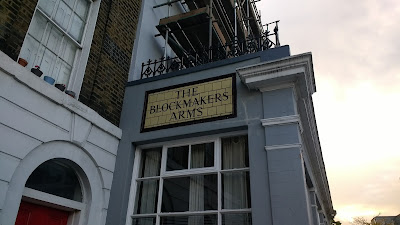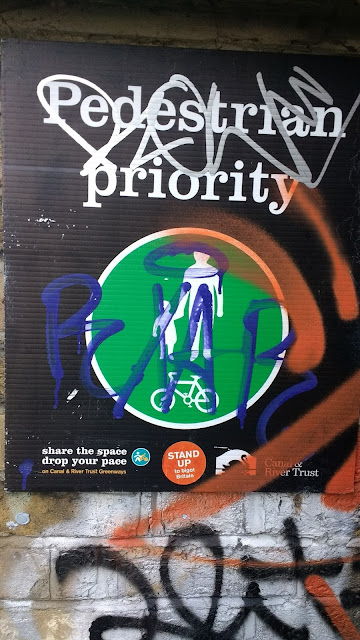Leaving the station at Sheffield we were confronted by the steel wall of the Cutting Edge sculpture. An 81 foot long graffiti proof water fountain, this is part of something called the 'Gold Route'. A series of spaces and streets incorporating public art, intersecting with both Universities and the main shopping 'spine', representing 'The Heart of the City'. We weren't aware of this formal route while we were there but our walk took us through its early stages. Had we not been heading for the Millennium Gallery anyway, I'm sure we would have found ourselves pulled in it's direction.
Along the way there was street art complimented by giant poems on the side of buildings, written by ex-poet laureate Andrew Motion and Ian McMillen (that bloke from 'the Verb' on Radio 3). The painting on the side of the building below is Harry Bearley , credited as being the inventor of stainless steel.
 |
| Poetry in Motion..... |
The man in question, it turned out, had worked in the steel industry in some capacity since he had left school, and was a victim of its decline. In his 60s and baffled by the internet age, he had been left behind by technology after being made redundant. I got the impression he was a frequent visitor to the cutlery room and would to talk to anyone who would listen about the industry, it's decline and his plight. The environment of the Millennium Gallery seemed to represent rejuvenation of the city and hope for the future. This man was a living ghost of its recent past, haunting the cutlery room as an inconvenient reminder of the washed-up and de-skilled. The cruel irony of all this was all too apparent. But he did go on. As we attempted to politely extract ourselves from his rambling monologue, he recommended the pubs of Kelham Island where he said he was heading later. A good pint of Barnsley Bitter could still be had, he said.
Between the encounter with cutlery man and the teacher, in another part of the gallery I saw an excellent exhibit about the journey of tomato seeds through the sewage system. Tomato seeds remain intact when they pass through the human digestive system, and during their journey through the sewage system, ending at waste dumps where the sludge is piled up and tomato plants thrive. The main part of the exhibit was a film on loop depicting the journey of the the tomato seed through the liminal civil engineered landscape. The artist harvested fruit from some of the plants, had it checked out and found it was safe to eat so made some jars of 'Shit Chutney'. More about this can be found at the artist Ruth Levene's website. Some of her other work covers maps, water and walking and is worth checking out.
Away from the gallery we found ourselves in a square featuring a temporary 'seaside' with fairground rides, stalls and somewhat alarming rubbish bins.
A short distance from this we found ourselves in an area evidently in the process of 'development'. The Salvation Army had abandoned it's citadel. I didn't know the Sally Army had citadels. Such things sound a bit exotic for an organisation associated with Jesus, temperance and brass bands. But I liked the building and felt sad that it might be demolished to make way for something far less interesting.
Near a car park and what was left of light industrial/workshop type buildings the other end of this street, a sort of army Captain was depicted, maybe a Salvation Army Captain as viewed by a less temperant member of the community. Maybe pointing in warning of both 'the drink' and of the bland shopping centre that the notices nearby showed planned for the area.
We had planned to visit the iconic bookshop Rare and Racy, but it turned out it had recently closed. Devonshire Road (in the 'Devonshire Quarter') was undergoing development. Jarvis Cocker from Pulp viewed the idea to close the shop as a crime and somebody the local paper asked said they would not walk down that stretch of road anymore. The street currently has a mixture of coffee shops, restaurants, vintage clothes emporiums and a miscellany of other independent shops, but there is concern whether these will last before more bland development and more generic chain outlets move in. Same old story. I acquired a very fine suede jacket in one of the shops, getting a bargain and doing my bit to support them.
The woman who sold me the jacket said the area had some shops in the street could do with improvement. I'd noticed a Private Shop nearby and wondered if she had been referring to it. The chain of sex shops always seemed to locate in slightly less salubrious parts of town. We have one in Cambridge on Chesterton Road, which is another area currently undergoing a sort of post-hipster gentrification. I've often wondered how on earth such shops keep going in the age of the internet and relentlessly bland urban development. You'd have thought they would have declined at a similar rate to 'bramble mags' which, like white dogshit, you rarely see anymore. While I'm not inclined to go into such places, I think as long as they exist they represent something 'other' and have the ability to make passers by feel a bit uncomfortable in their surroundings. As such they give two fingers to those who want to 'smarten up' areas to the point of sterility.
Not far from the vintage shop we saw a man my partner was convinced was on the 'zombie' drug 'spice' standing (just about) on a corner. Another man was sprawled half unconscious outside a pub. She maintained he must have been on spice too. It was hard to argue that the bloke may have just been very pissed considering the pub had only just opened and I don't doubt she was right. The contrast between the men out of their heads and the future aspirations of the encroaching developers on the Devonshire Quarter seemed to symbolise the opposite and grim ends of the pole of contemporary urban development and (post) modern Britain in general.
The mural above was somewhere at the end of the road. The area has a good amount of streetart. This one done by Tellas, an Italian artist, was part of something called 'Feature walls' in 2016. The street art of the City is extensively documented on Street Art Sheffield, including a map which would be good for anyone wanting to conduct a 'street art' walk.
Soon after we found ourselves in the pedestrianised shopping area known as The Moor. The link is actually for an article about 'The Moor Quarter' which presumably includes a slightly wider area. This is one of the major shopping areas in the City. It was good to see it thriving despite the presence of the out of town Meadowhall, which at one time was seen as a threat to city centre shops. I'm not a great one for shopping but if I have to a shopping street, without a roof over it, is in my view far preferable to an out of town covered 'Mall' with its own security guards and terrible piped music. I went to Meadowhall on a geography field trip in the early '90s and found the experience profoundly uninspiring.
Across the road at the end of the street we walked past the giant brown ziggurat-like behemoth of the Moorfoot building dwarfing a small precinct of shops at its base. The building housed Civil Servants from various Government Departments until 2014. Now it's occupied by Sheffield City Council, following an abandoned plan to demolish it. The building dates from 1981 and originally had a staff restaurant, a rarity these days in the workplace and bar which is even rarer.
The other side of the building we crossed the inner ring road through an impressive underpass which I failed to photograph. Over the other side, at the end of London Road, the face above may have been trying to scare us off. I read somewhere later that London Road had a reputation for drugs and violence. We saw some rowdy football fans (there was a match on, one of the Sheffield football teams plays not far away), and a couple of dodgy looking blokes outside a pub. But a bit further down the road were newer coffee bars and restaurants opening.
Before we started down the road I was trying to photograph the Chinese Fireworks Company. I always seem to encounter establishments connected to fireworks on these walks. I only managed the effort below before my partner suggested we move on swiftly. She'd spotted Cutlery Man in a nearby phone box looking for money or fag butts. We didn't have time for a second prolonged encounter with him and luckily he didn't see us.
Just further up is a Sainsburys housed in what's left of a former cinema. The facade is retained but much of the original building was demolished as part of a development. The building had been used as a nightclub called Tiffany's in the 70's and more recently known as known as 'Bed' before closing down.
We were heading towards Abbeydale Road, a long stretch in the 'Antiques Quarter'. Unfortunately the splendidly named Rude Shipyard, the first shop we passed,was closed. The name made me wonder if the proprietor was an antique selling nautical version of Bernard Black from the TV comedey 'Black Books'. The road contained various other antique/vintage/junk shops. There is also a cafe, said to be frequented by scooter boys and mods from the Ace Scooter Club but there was no sign of them when we went by, just a lady in a Sari. Maybe they had given up scooters, tonic suits and fry ups for expensive push bikes, beards and posh javas at the new cycling cafe nearby.
The splendid building below appeared pretty derelict from a distance. The Abbeydale Picture House dates from 1920. The original cinema closed in 1975 and was subsequently used as a furniture showroom and then a snooker hall and bar. The building is listed and attempts were made to restore it by the 'Friends of the Abbey Dale Picturehouse' between 2003 and 2012, These 'friends' included Michael Palin and Peter Stringfellow, an alliance I am trying hard to imagine. According to wikipedia, in 2012 the venue hosted a stage version of Hi-De-Hi, an 80s sit com based on a Butlins-style holiday camp in the 50's. Later in the year the Friends went bust. Eventually the lease was acquired by the Sheffield based arts charity CADS which facilitates film screenings, music events and flea markets while restoration work and fundrasing continues to take place.
On the wall outside, a black fox. Not sure if a black fox is a similar portent to the Black Dog, or if this was some sort of warning sign or maybe a homage to a local beast? It turns out there are others painted on walls in and around Abbeydale Road. The artist and the motivation behind them appear to be a mystery, in the same vein as the 'Lewisham Natureman' White Stag in South East London or the Heron in Cambridge. Although in the latter case, the artist has spoken to the local press and has Facebook and Twitter accounts but attempts to keep his identity hidden.
Further up we stopped in a vegan cafe for tea and cake. The cake selection was excellent, portions large and very reasonably priced. Fortunately we had finished when a woman came in and stated that ten of her friends would be turning up shortly, some with pushchairs and babies. The proprietor obligingly moved tables and chairs to accommodate their imminent arrival. The scraping of chairs on the floor and prospect of the hubbub to come hastened our departure.
After a rummage round an impressive three story junk/vintage/antique emporium we took a right turn off Abbeydale Road with a vague intention to visit a vegan cafe for lunch, the name of which I can't remember but it had a good write up. It was too busy when we got there so we didn't bother. The nearby osteopath sported some novel advertising in the form of a skeleton, with what looked like immaculate bone structure and sporting some fine socks and a scarf.
A little further along, and up a bit of an incline, we passed these beehives in someones garden. I'm not sure if they were occupied or if Bob Marley and the Beatles have any association with bee keeping.
After this there is something of a gap in my photographic record. The beehives, and the pictures above are from, I think, the area called Nether Edge. We were heading for the Botanic Gardens where we thought we'd have a rest but went slightly of course and found ourselves in the evidently very popular Endcliffe Park. Ecclesall Road, which runs along the south east corner of the park had been on the original hit list from the guide. I can't recall why exactly and we didn't walk down much of it in the end but I suspect I might have been hoping for a crafty beer in the Portland House micro-pub. We never got there. Wards Brewery was located along the road until 1999 and is now the sight of luxury flats (really?!). The old sign still stands. We didn't get there either.
Endcliffe Park is bisected by the Porter Brook. The name derives from the brown colour the water takes on after passing over iron-ore deposits, making it resemble dark beer. Porter Brook rang a distant bell and the park felt familiar. I was fairly sure this was the place I visited on the geography field trip where I thought I'd broke £1000 worth of river velocity reading equipment. We'd followed the brook (I think it was the Porter) from a tributary out in the sticks and eventually were dropped off in what I'm sure was Endcliffe Park for our final reading. My memory of the park the first time was of somewhere much smaller and quieter. This time it seemed large, noisy and busy with ice cream vans and people playing football. It was good to see people outside doing things.
After a meander through the park, we found ourselves in a part of town that seemed to be a University area, with large houses and places that looked like halls of residence. The environment didn't change until we reached the Botanic Garden. The garden features an impressive pavilion building. There was a wedding going on in it so we couldn't go in. The gardens were more like a normal park than the Cambridge Botanic Garden and unlike the Cambridge version, free to get in.
We headed back towards the centre through Nether Edge (I think). At some point, just before we crossed the inner ring road we could hear loud dub step type music getting progressively louder as we approached. Id assumed we were about to encounter a gig in a park. But on side road there was a party going on and the music seemed to be coming from somebody's house.
After crossing the ring road we made our way through what looked like an ex-industrial area against a ride of football fans heading home after the game. Stokes Tiles and similar buildings appeared abandoned but it being Saturday it was hard to tell.
After passing back through The Moor we found ourselves in the other main city centre shopping street, the other side of the urban seaside we'd visited earlier. It appeared a Tardis had parked.
We found ourselves back near the Millennium Gallery, and passed through Millennium Square. I was taken with the building at the back of the photo below and wondered what it was. It turns out it's the Charles Street Car Park, or 'The Cheesegrater'. In 2013 it was named as the third coolest car park in the world. Here's all ten. By then the 'Get Carter' car park in Trinity Square in Gateshead had been demolished so was out of the running for such accolades. It made way for a new Trinity Square development which includes a very large Tesco Extra, and was nominated for the 2014 Carbuncle Cup. The Millenium Square was much more pleasant than anywhere with a Tesco Metro and far from a carbuncle. I'm not often impressed with these sorts of developments, and while it had some of the same features as countless others (Pizza Express etc), there was something different about it. Maybe it was the calming effect of the water flowing over the 9 steel balls.
The balls represent steel industry heritage (steel, craftsmanship, water, stonework). They looked more gold coloured than steel to me. This may have been a figment of my imagination or faulty eyesight.
Just before the station we passed the vulture mural below. In the other direction, from the front of the station you can see Park Hill. I wondered if the vulture mural might be a swipe at the re-development/renovation/sticking up coloured plastic bits being carried out by Urban Splash. Similar to what has happened to the Trellick Tower in East London, luxury and upmarket apartments are being created in a Brutalist development inspired by Le Corbusier and originally a council estate. These dwellings, and those who lived there, would have been derided in the not too distant past as a problem. But these days they are highly sought after. Maybe it's better than them being torn down completely. But it does bring the expression 'social cleansing' to mind. Architects For Social Housing (ASH) have quite a bit to say about that.
I would have liked to have had a wander around Park Hill but we had to catch the train and were knackered. It's reputation in the past was not good. A friend of mine at Uni planned to do some research for his dissertation there but his mum wouldn't let him. He told me of incidents where people had heavy items thrown/dropped on them from balconies. So back then I probably would have avoided it. Whether it was really that bad, I don't know. And maybe going there now for a wander round would be an act of heritage tourism and an insult to those being decanted out when their homes are demolished.
We also never got to Kelham Island for a pint of Barnsley Bitter.
